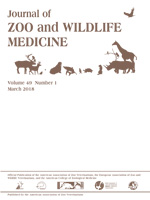The combination of fentanyl and midazolam is commonly used as a sedative in humans. The objective of this study was to evaluate the sedative properties and physiological effects of fentanyl-midazolam and fentanyl-midazolam-ketamine compared with medetomidine-ketamine given intramuscularly in Japanese macaques (Macaca fuscata). In a randomized crossover design, eight Japanese macaques were hand-injected with either 30 μg/kg fentanyl 0.3 mg/kg midazolam (FM), 15 μg/kg fentanyl 0.3 mg/kg midazolam 5.0 mg/kg ketamine (FMK), or 0.05 mg/kg medetomidine 5.0 mg/kg ketamine (MedK). Heart rate; indirect systolic, mean, and diastolic arterial pressure; respiratory rate; blood gas concentrations; rectal temperature; and duration of immobilization were recorded. Mixed linear models were used to evaluate the effects of drug treatment on all continuous variables, with a significance level of P < 0.05. Only three of seven animals receiving FM were successfully immobilized. All eight animals in both the FMK and MedK treatment groups had a rapid, smooth induction and were successfully immobilized. Both FMK and MedK treatments resulted in significant hypoxia and the animals required supplemental oxygen via face mask. The mean duration of FMK immobilization was 42 ± 10 min, significantly shorter than the 65 ± 14 min for the animals receiving MedK. Immobilization with MedK resulted in significantly lower heart rates, and significantly higher arterial pressure compared with FMK. Hypoventilation was significantly more pronounced in FMK-treated animals compared with MedK treatments. Immobilization with FMK resulted in a gradual, slow recovery whereas MedK-treated animals woke up more rapidly. Fentanyl-midazolam alone is not a useful sedative in Japanese macaques. A combination of fentanyl and midazolam with ketamine can be used as an alternative to medetomidine-ketamine in this species.
How to translate text using browser tools
1 March 2018
COMPARISON OF INTRAMUSCULAR FENTANYL-MIDAZOLAM, FENTANYL-MIDAZOLAM-KETAMINE, AND KETAMINE-MEDETOMIDINE FOR IMMOBILIZATION OF JAPANESE MACAQUES (MACACA FUSCATA)
Rolf-Arne Ølberg,
Melissa Sinclair,
Ian K. Barker,
Graham Crawshaw
ACCESS THE FULL ARTICLE
fentanyl
immobilization
ketamine
Macaca fuscata
medetomidine
midazolam.





